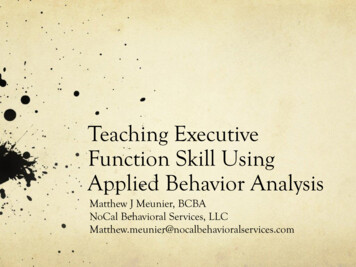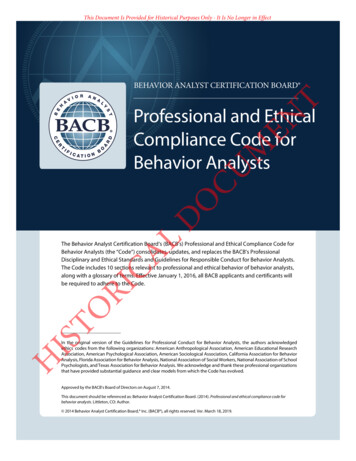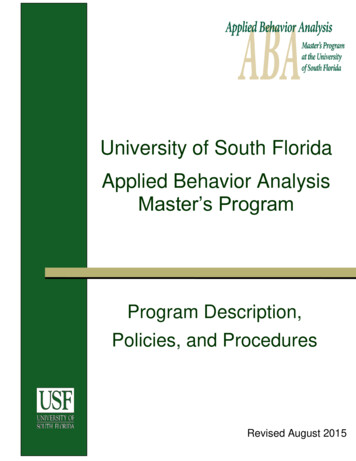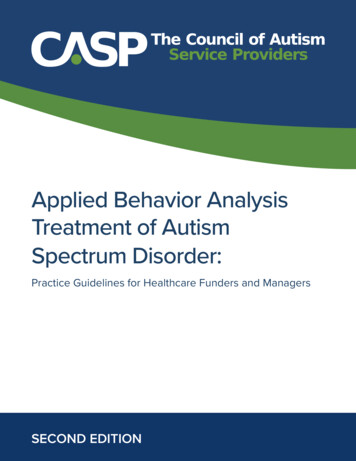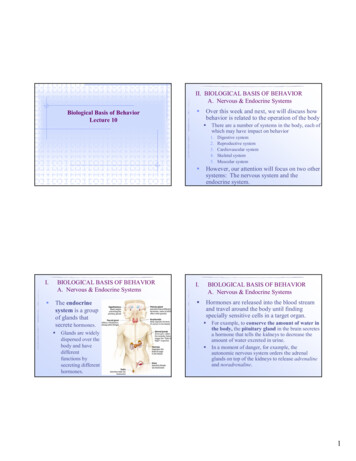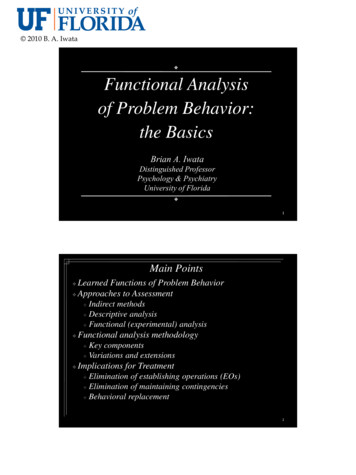
Transcription
2010 B. A. Iwata Functional Analysisof Problem Behavior:the BasicsBrian A. IwataDistinguished ProfessorPsychology & PsychiatryUniversity of Florida 1Main PointsLearned Functions of Problem Behavior Approaches to Assessment Indirect methods Descriptive analysis Functional (experimental) analysis Functional analysis methodologyKey components Variations and extensions Implications for TreatmentElimination of establishing operations (EOs) Elimination of maintaining contingencies Behavioral replacement 2
2010 B. A. IwataSpecial NoteJABAJournal of Applied Behavior AnalysisSpring 2013 (Vol. 46, #1) Special issue on functional analysis 31 articles on various aspects of assessment & treatment 3Why do people engage in problem behavior?Biology: Physiological predispositionGenetic endowment behavioral capacities Physiology does not produce specific problem behavior Personality: Mental or emotional disorderBehavioral symptoms clinical diagnosis Clinical diagnosis explanation for symptoms Environment: Learning history Experience new behavior Certain experiences problem behavior4
2010 B. A. IwataStructural vs. Functional AnalysisStructural analysis: Identification of parts or components General: Of what is this thing made? Environment & behavior: What events are happening? Functional analysis: Identification of uses or purpose General: What does this thing do? Environment & behavior: Why are these eventshappening? 5Functional Analysis of BehaviorPurpose: To identify the variables of which behavioris a function; to discover "cause-effect”relationships (Skinner, 1953) Goals: Understanding Treatment Prevention 6
2010 B. A. IwataLearned Functions of Behavior DisordersAssumptions Most behavior problems are learned Adaptive and maladaptive behavior have common functions Positive Reinforcement (Sr , reward) Social (attention, access to tangible materials) Automatic (sensory stimulation) Negative Reinforcement (Sr-, escape or avoidance) Social (escape from task demands) Automatic (pain attenuation) 7Social-Positive Reinforcement(Social Sr )Antecedent event(Deprivation from attention) Behavior(SIB, AGG, PD, etc.) Consequent event(Blocking, reprimand, comfort,leisure items, snacks, etc.)8
2010 B. A. IwataFunctionAntecedent(EO)Consequent(Sr)Social PositiveReinforcementDeprivation(no attention)AttentionAutomatic PositiveDeprivationReinforcement(no sensory stimulation)Sensory stimulationSocial NegativeReinforcementAversive stimulation(task demands)Removal of taskAutomatic NegativeReinforcementAversive stimulation(pain or discomfort)Alleviation of pain9Self-Injurious Behavior (SIB)Behavior that produces injury to the individual’s own body Biting:Eye Gouging: Head Banging: Hitting:Pica: Rumination: Scratching:Closure of upper / lower teeth on the skin(also mouthing and sucking)Finger insertion into the ocular areaForceful contact of the head with astationary objectForceful contact of one body part withanother or with a stationary objectIngestion of inedible substancesRegurgitation and reswallowing ofpreviously ingested foodRaking-like or picking movement offingernails on the skin10
2010 B. A. IwataFunctional Behavioral AssessmentPrecisionLeastAnecdotal (Indirect) MethodsMost Descriptive (Naturalistic) Analysis Functional (Experimental) AnalysisMostLeastTerminology Functional behavioral assessment (FBA): Any systematic attempt to identify sources of reinforcement for problem behaviorFunctional analysis (FA): Use of the experimental model toidentify cause-effect (environment-behavior) relations11Kahng et al. (AJMR, 2002)250Cumulative Number of Data Setsby Type of Assessment200NUMBER OF DATA SETS Simplicity150Experimental AnalysisDescriptive AnalysisIndirect 00012
2010 B. A. IwataIndirect (Anecdotal) MethodsGeneral Characteristics Focus on circumstances under which behavior occurs Based on informant recall (no direct observation) Examples MAS (Motivational Assessment Scale) QABF (Questions about Behavioral Function) FAST (Functional Analysis Screening Tool) Advantages Simplicity, efficiencyLimitations Poor reliability, questionable validitySuggestion for implementation Use only as a preliminary guide13Descriptive (Naturalistic) AnalysisGeneral Characteristics Direct observation of circumstances under whichbehavior occurs Examples Scatter plot: Temporal recording of behavior ABC analysis: Recording of interactional sequences Interval recording: Temporal recording of rapid sequences Advantage More reliable than indirect methodsLimitations Structural analysis only; no information about function14
2010 B. A. IwataScatter PlotScatter PlotClient:1Data Grid Rows: 30-min intervals Columns: days Summary at bottomRecord at end of 30-min intervals Blank: No PB / (yellow): A little PB X (red): A lot of PB2345678Behavior: Month:9 10 11 12 13 14 15 16 17 18 19 10 21 22 23 24 25 26 27 28 29 30 005:303025# of Itervals !Summary # intervals with PB24-Hr Analysis/Summary Graph2015105051015DAYS20251530 1996 The Florida Center on Self-InjuryA-B-C AnalysisPurpose To identify naturally occurring, observable antecedents andconsequences of behaviorTypical procedure Define target behaviors (B)Specify criteria for antecedent (A) and consequent (C) eventsOccurrence of B Record A, B, and COrganize A-C clustersGenerate hypothesis based on A-C correlations with B16
2010 B. A. IwataA–B–C FormAntecedent-Behavior-Consequence (ABC) AnalysisClient: Observer:Target quencesLayout Client info Time Location Antecedent: Precedes PB Behavior: Target PB Consequence: Follows PBRecord Occurrence of PB serves asoccasion for recordingSummary Organize A & C events intofunctional groupings17Functional (Experimental) Analysis General Characteristics Systematic exposure to controlled assessment conditions Variations BFA, single-function, trial based, latency, precursorAdvantage Test: Suspected antecedent and consequent presentControl: Suspected antecedent and consequent absentMost precise method of assessmentLimitation Most complex approach18
2010 B. A. IwataSome Key Terms Antecedent event: Establishing operation (EO)Alters the effects of a reinforcer EO present: Sr more valuable EO absent: Sr less valuable Example: Food deprivation food more valuable Antecedent event: Discriminative stimulus (SD)Stimulus in whose presence reinforcement is more likelySD present: Sr availableD S absent: Sr unavailable Example: Traffic light Stop/go more likely to be reinforced Consequent event: Reinforcement contingency (Sr)If-then relation between a response and a consequence Contingency present: Behavior maintains Contingency absent: Behavior extinguishes 19Functional Analysis ProtocolConditionSDAttentionTh 1 Th. ignores Cl. Th. attends tobeh. problemPositive rfmnt(attention)DemandTh 2 Th. presentslearning trialsNegative rfmnt(escape)AloneN/ANo stimulationPlayTh 3N/AN/AAttn: FreeDemands: NoneToys: FreeEOConsequenceTimeout forbeh. problemN/AContingencyN/AAutomatic reinf?Control20
2010 B. A. IwataTypical Response PatternsFunction: Social Positive Reinforcement (attention)RESPONSES / MIN10ALONEATTENTIONPLAYDEMAND8642RESPONSES / MIN015 05101520051015200510SESSIONS1520Function: Social Negative Reinforcement (escape)1050RESPONSES / MIN15Function: Automatic Reinforcement (self-stimulation)105021Multielement DesignMultielement Design4030AttnDemandAlonePlay20100051015202530Key feature All conditions alternated rapidly Advantages: Most efficient for multiple comparisons Limits exposure (sequence effect) Limitation Requires rapid discrimination 22
2010 B. A. IwataReversal DesignReversal 1015202530Key feature Repeated exposure to each condition Advantage: Facilitates discrimination Limitation Potential sequence effect 23Pairwise Test-Control DesignPairwise Test-Control Design40Attention v. PlayDemand v. PlayAlone v. Play30201000102030Key features Single test and control conditions alternated Test conditions arranged in reversal sequence Advantage: Combines best features of multielement andreversal designs (facilitates discrimination,controls for sequence effect) Limitation: None 24
2010 B. A. IwataChallenges to Functional AnalysisMethodologyComplexity of assessment: It’s too difficult Time constraints: It takes too much time Setting constraints: I don’t have a controlled setting High-risk behavior: It’s too dangerous Low-rate behavior: I never see the behavior Uninterpretable results: I can’t identify the function 25Complexity of Assessment: Logic & DataLogical analysis What skills are required to conduct a functional analysis? Empirical analysis Undergraduate students (Iwata et al., 2000) B.A.-level therapists (Moore et al. 2002) Teachers (Wallace et al., 2004) Teleconferencing (Barretto et al., 2006) 26
2010 B. A. IwataTime ConstraintsBrief Functional Analysis (BFA)15AloneAttn10PlayDemand500123427Time Constraints: Single Function Tests10RESPONSES Northup et al. (1991): One, 5-min session of each conditionDerby et al. (1992): 50% functions identified PONSES 86Client 1: MaintenanceClient 2: Extinction4200246810SESSIONS28
2010 B. A. IwataSetting Constraints FA in the home? Day et al. (1994), Harding et al. (2001), Nadjowski et al. (2008)Typical FA in typical classroom? Berg et al. ( 2007); Derby et al. (1994); Dolezal & Kurtz (2010); Frea & Hughes (1997); Grauvogel & Wallace (2010);Lang et al. ( 2008, 2009, 2010); McComas et al. ( 2000, 2003);Mueller et al. (2003); O’Reilly et al. ( 2009)29Classroom-Specific, Trial-Based FA(Bloom et al., 2011, 2013; Kodak et al., 2013; Lambert et al., 2013)Classroom restrictionsRapidly changing activities Brief sessions Contiguous test-control comparison (control precedes test) Capitalize on naturally occurring activities Study arrangement (Bloom et al.): 4-min trial 2-min control PB yes or no 2-min test PB yes or noRecommended arrangement: 5-min trial 1-min control PB yes or no 4-min test PB yes or no30
2010 B. A. IwataFA Trials Attention (no tasks present) Control: Stand near student; initiate pleasant conversation Test: Stand near student but ignore; deliver attention onlyfollowing problem behavior Task Demand Control: Observe while no task demands are present Test: Deliver frequent prompts to engage in difficult work;remove work following problem behavior Alone Two consecutive test segments. Observe when student is notworking, not interacting with others, and has no access toleisure items31Correspondence: Social Sr 32
2010 B. A. IwataCorrespondence: Social Sr-33High-Risk BehaviorLatency FA (Thomason, Iwata, Neidert, & Roscoe, 2011, Study 3) N 10, SIB or AGG Latency FA Deliver consequence for 1st response and terminate session(or if no response in 5 min)Measure: # seconds to occurrence of 1st responseTypical FA: Standard protocol, 10-min sessionsResults: 9/10 correspondence 34
2010 B. A. IwataCorrespondence: Social Sr (Attention)Latency (S) to Aggression300200(5 ion (RPM)81012Sessions4(108 Responses)32100246810Sessions35Correspondence: Social Sr- (Escape)Latency (S) to Aggression300200AttentionDemandPlay(17 Responses)100Shane0051015202530Aggression (RPM)21.51(77 Responses)0.5005Sessions101536
2010 B. A. IwataPrecursor Behavior & Response ClassesDefinition Topographically different than target responsePrecedes and predicts occurrence of targetChain relation (sequence of responses, different reinforcers) Put on coat (stay warm) walk out door (go somewhere) Get out of chair (close to target) aggression (attn or escape) Response class (substitutable responses, same reinforcer) Ask for water (water) go looking for water (water) Swear at teacher (escape) aggression (escape)37High-Risk BehaviorAnalysis of precursor behavior (Smith & Churchill, 2002) N 4 (3 SIB, 1 AGG) FA #1: Contingencies on SIB / AGG FA #2: Contingencies on precursor Rs Results: 4/4 matched FAsSIB lower during FA of precursor RImplicationsIf one can identify a precursor to PB, and If precursor and PB members of the same functional class FA of precursor function of PB Treatment of PB based on function of precursor 38
2010 B. A. IwataWhy does Problem Behavior Occur at Low Rates? Insufficient exposure to test condition Idiosyncratic EO or reinforcer Divided attention condition (Mace et al., 1986)Combined contingencies (Sr and Sr- simultaneously) Do not combine PBs (Richman et al., 1999)Combined EOs (same maintaining contingency) See reviews (Hanley et al., 2003; Schlechenmeyer et al., 2013)Response class hierarchy Lengthen sessions (Davis et al., 2012)Escape to tangible condition (Zarcone et al., 1996)Covert behaviorHidden observation (Ringdahl et al., 2002) Response product measures (Maglieri et al, 2000) 39Undifferentiated Results: Case Analysis(Hagopian et al., 2013)Modifications to 82 undifferentiated FAs Most effective: Design change (pairwise, extended “alone”)nd most effective: Separating aggregate responses 2 Least effective: Antecedent changes (location, stimuli)Results One modification: 55/82 cases clear Two modifications: 16/24 cases clear 8 cases unresolved40
2010 B. A. IwataSummary of Functional Analysis VariationsLimitationSuggestionComplexity Sorry, I cannot help youTime BFA (extended), Single-function testSetting Trial-based FARisk All approximations and occurrences,Low-rateA messProtective devices, Latency or Precursor FA Lengthen sessions, combine EOs orcontingencies, unobtrusive observation Simplify design, separate PBs41RECAP: Functional Behavioral AssessmentIndirect Methods Simple but unreliable DA: Descriptive (Naturalistic) Analysis Reliable but time consuming; structural analysis only FA: Functional (Experimental) Analysis The gold standard but complex Common recommendations Three-stage assessment: Indirect DA FA Two-stage assessment: DA FA My suggestion: Neither42
2010 B. A. IwataWhat about DA vs. Indirect Methods?ABA based on scientific study of human behaviorEmphasis on objective measurement Direct observation (DA) superior to opinion (indirect)BUT DA: Objective approach to structural analysis Indirect: Subjective approach to functional analysis And if you read the research carefully:Neither method identifies cause-effect relations very well DA much more complex than indirect DA takes about 15-20 times longer than indirect Clinical interview easily accommodates indirect assessment DA poses some risk; Indirect poses none Indirect errors probably random; DA errors probably biased So . . . which would you use?43Recommended Assessment SequenceStep #1: Clinical interview MAS, QABF, or FASTStep #2: Brief (10-15 min) observation (or skip entirely)Step #3: Functional analysis (FA, BFA, single functiontest, trial-based FA, latency FA, precursor FA)Rationale: Clinicians may do #1 well but not #2 or #3.Compare the value of watching a client for 30 min (#2) vs.seeing what a client does when ignored, when presentedwith demands, etc. (#3)44
2010 B. A. IwataBarriers to ImplementationCurrent status of FA methods The standard in clinical research and practice Still not the the most common approach to assessment Why the 30 year lag in widespread application?Commonly mentioned limitations Practical constraints Ethical issuesThe real barriers Most academics have never conducted an FA of PB Most graduate students never learn how to conduct an FA DA is an excellent structural analysis (A B C) Everyone knows how to conduct a DA45 ImplicationsforIntervention 46
2010 B. A. IwataClassification of Intervention Procedures Structural approach: Emphasis on procedures Advantage: Well-defined practice guidelines Time out, overcorrectionDisadvantage: Behavior chance mechanisms unknown(Same procedure different results) Planned ignoring extinction vs. Sr Reprimand punishment vs. Sr Functional approach: Emphasis on contingencies Advantage: Generalizable across response functions Extinction cessation of reinforcementDisadvantage: Procedural details not well specified Extinction what procedures?47Reinforcement-Based Approaches toBehavior Reduction Eliminate the behavior’s establishing operation orantecedent event (deprivation or aversive stimulation) Noncontingent reinforcement (NCR)Eliminate the behavior’s maintaining contingency Extinction (EXT)Replace the behavior with an alternative response Differential reinforcement (DRA)48
2010 B. A. IwataFunction: Social Positive Reinforcement Establishing operation: Deprivation from attention Noncontingent attention (NCR) Maintaining reinforcer: Attention EXT (attention) or “planned ignoring” Behavioral replacement: Establish an alternative attention- seeking response49Function: Social Negative Reinforcement Establishing operation: Aversive stimulation (e.g., demands)Noncontingent breaks from work (NCR) Maintenance tasks substituted for acquisition tasks Reduced session duration Demand fading (frequency or difficulty) High probability (Hi-p) instructional sequence Noncontingent Sr Maintaining reinforcer: Escape EXT (escape); EXT (attention) contraindicatedBehavioral replacement:Reinforce precursor behavior Establish an alternative escape behavior Strengthen compliance via Sr- and Sr 50
2010 B. A. IwataFunction: Automatic Positive Reinforcement Establishing operation: Generalized deprivation Noncontingent stimulation (NCR) Maintaining reinforcer: Sensory stimulation EXT (sensory); mechanical devices, blocking, etc. Response effort inerventions Behavioral replacement: Establish an alt. self-stimulatory response51Multiple Control - TreatmentFunctionsSocial Sr Social SrSocial Sr Automatic Sr Social SrAutomatic Sr latoryResponseXXXThe problem: Social Sr & Social Sr Extinction procedurally incompatible across functionsSr (terminate interaction) vs. Sr- (continue interaction)Use context as the determinant of intervention Demands absent: Assume Sr ; Demands present: Assume Sr 52
2010 B. A. IwataSummaryYou SHOULD conduct a functional analysis More reliable than a questionnaire or rating scale More efficient and precise than a DAYou CAN conduct a functional analysis Easy to do (control antecedent and consequent events) Procedural variations for almost all limiting conditionsResults of a functional analysis Identify effective reinforcement-based interventions53
Functional Analysis of Problem Behavior: the Basics 1 Brian A. Iwata Distinguished Professor Psychology & Psychiatry University of Florida Main Points Learned Functions of Problem Behavior Approaches to Assessment Indirect methods Descriptive analysis Functional (experimental) analysis Functional analysis methodology Key components




